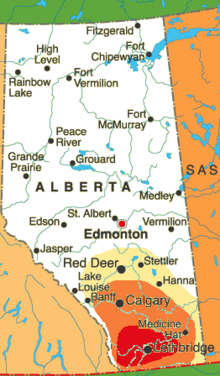Chinook is claimed by popular folk history to mean "Ice-Eater". Actually, it is the name of the people in the region where the usage first derived. The reference to a wind or weather system, 'a Chinook', originally meant a warming wind from the ocean into the interior regions of the Pacific Northwest of the USA. The Chinook people lived near the ocean along the lower Columbia River.
Chinooks are most common over southern Alberta, especially in a belt from Pincher Creek and Crowsnest Pass through Lethbridge. On average, there are 30-35 Chinook days per year. Chinook winds can gust in excess of hurricane force 120 km/h (75 mph). Chinook winds have been known to raise winter temperature, often from -20C (-4F) to as high as 10-20C (50-68F) for a few hours or even days. A strong Chinook can melt one foot of snow (30cm) in one day. Then the temperature plummets back to its base level. Calgary, Alberta gets many chinooks-the Bow Valley in the Canadian Rockies west of the city acts as a natural wind tunnel, funnelling the chinook winds. I was caught in this tunnel, and I and the vehicle were like a steel ball rocketing within a pinball machine.
As I approached the mountains, the Chinook arch, a band of stationary stratus clouds caused by air rippling over the mountains, hovered above me. Though they look like a threatening storm cloud at times, they rarely produce rain or snow. However, many times after travelling under a Chinook arch in the foothills, I have arrived home in Banff greeted by dark skies and flurries.
Entering the mountains and rolling down the road towards Banff, the gusts of wind, while still frequent, were less powerful. Once in Banff, I parked the van in the industrial compound and began to walk home. Now physically exposed to the force of the Chinook winds, I quickly put my ball cap away and pulled my toque over my ears. I have arrived, I am home.
Robert Krysak


No comments:
Post a Comment